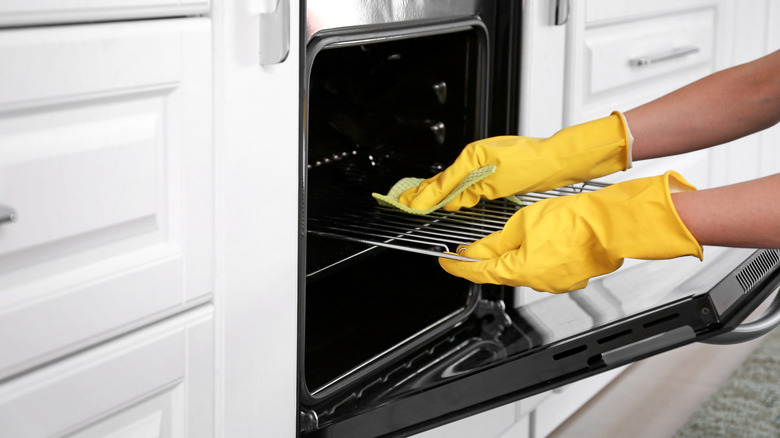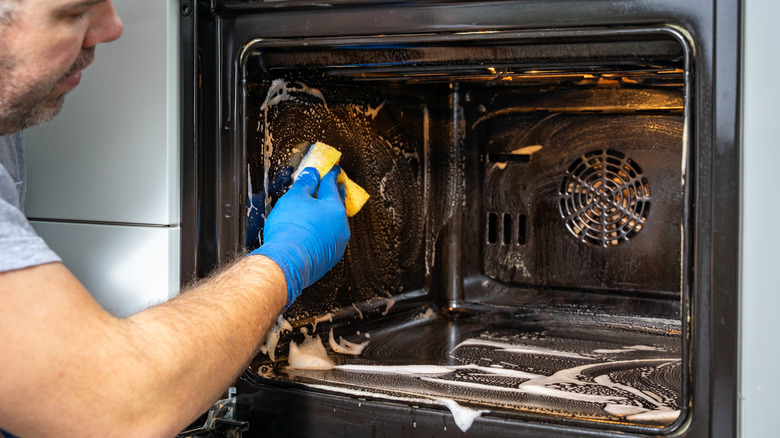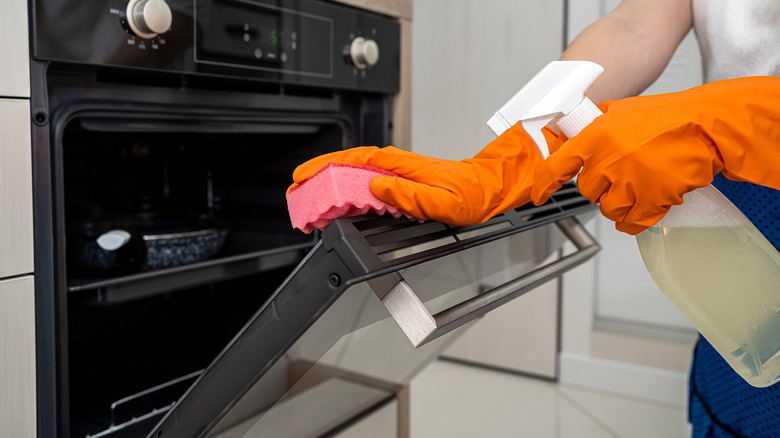What Does It Mean If You Have A Self-Cleaning Oven?
Cleaning your oven can be such a dilemma, can't it? A clean oven is vital if you want to avoid triggering your smoke alarms or ruining all your hard work in the kitchen. Though cleaning is considered by most to be a dreaded chore, it's still necessary, especially for ovens. The longer you leave it dirty, the more probably it is that you will have to use harsh cleaning agents that contain harmful fumes you do not want to breathe in.
If even discussing cleaning your oven is causing you dread, let us welcome you to the world of self-cleaning ovens. These appliances can help you save both time, and money you might otherwise spend on cleaning supplies. Aside from a fictional, never-ending supply of paper towels, a self-cleaning oven is arguably one of the most efficient elements of a kitchen. It might even seem too good to be true, but rest assured that it isn't; pyrolytic and steam ovens clean themselves with minimum intervention (via Whirlpool). A self-cleaning oven may be right for you if you are allergic to cleaning agents or simply dislike performing the chore. Here's how they work and how you should operate them.
How do self-cleaning ovens work?
The way in which a self-cleaning oven works depends on the type of appliance you have — either pyrolytic or steam, according to Whirlpool. Pyrolytic ovens warm the interior up to around 800 F, ensuring that any dirt is carbonized and turned to ash. This process is known as pyrolysis, which is where the name derives from. Steam ovens, on the other hand, clean themselves differently.
Inside the oven cavity of most steam ovens is a water canister. A pump injects water into the boiler, and the heat from the oven converts the water to steam. This ensures that moisture levels are maintained at appropriate levels and loosens away the dirt in your oven. The vapor is especially good at getting rid of debris such as oil and seasoning.
The difference between the two is that steam uses less heat, with the only trade-off being a more intense post-clean-up wipe. Steam-clean cycles are also designed for lighter jobs, compared to the pyrolytic function. However, if you often grill or roast meats and vegetables, a pyrolytic oven should be at the top of your home appliance wish list.
How do you operate self-cleaning ovens?
Similar to the previous slide, the way in which you operate a self-cleaning oven depends on the type you have, but both options are pretty straightforward according to instructions provided by HowStuffWorks.
If you have a pyrolytic oven, begin by removing anything detachable from the oven, including removable plastic oven handles and knobs. The exterior of the appliance will grow extremely hot as well, and you don't want these essential parts to melt inside your machine! In between cleanings, be careful about using harsh oven cleaners that can be affected by the extremely high temperatures. It's best to check your oven manufacturer's guide for details. After you've completed the preparation, you can schedule the cycle. Cleaning time ranges from 2 to 4 hours on average.
Since steam-cleaning ovens do not get as hot, you may leave racks inside during the cycle, if you like. To start, pour 1 cup of water into the bottom basin of the oven. You may use either commercial oven cleaners or natural alternatives in conjunction with steam cleaning, but make sure you read the manufacturer's instructions before proceeding. Close the door after selecting the steam cleaning option, and open up your space as much as possible for sufficient ventilation. The cycle will run between 30 minutes to an hour.
With both methods, you need to allow the oven time to cool down. Once cool, use a microfiber cloth to wipe away any ash, moisture, or remaining food residue.


